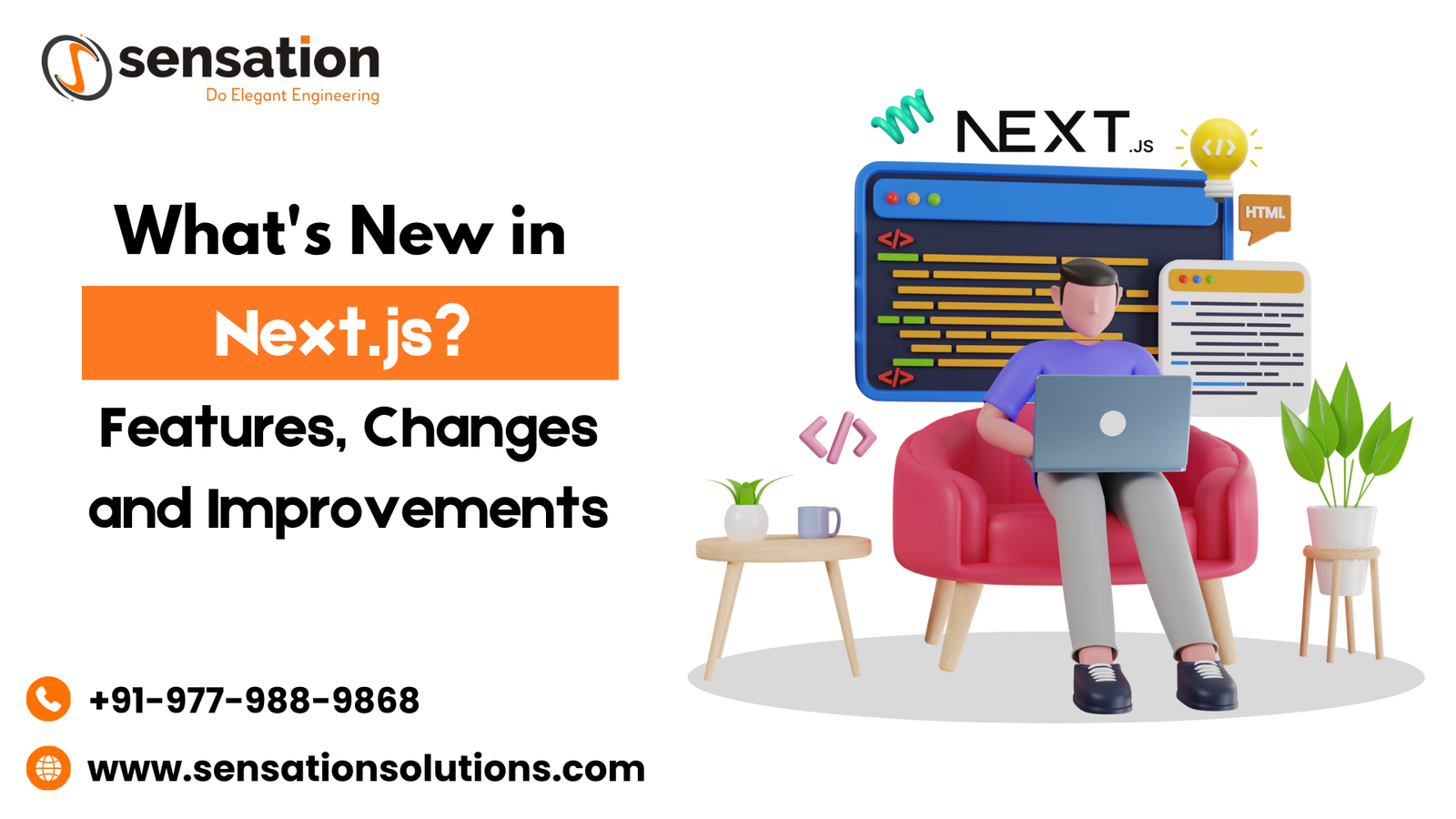What’s New in Next.js? Features, Changes, and Improvements

Table of Contents
Next.js, the React-based framework for constructing high-performance internet packages, keeps pushing obstacles with its modern launch, Next.js 15. Launched on Thursday, May 23rd, 2024, this replacement brings interesting functions and enhancements designed to enhance developer experience and application efficiency. Let’s dive into the heart of Next.js 15 and discover what it has to provide!
What is Next.js?
Next.js is an open-source framework built upon the foundation of React, a popular library for building dynamic user interfaces. It streamlines the development process for web applications by offering a robust set of features and functionalities. These features encompass:
- Server-side Rendering (SSR): Improves SEO and preliminary load times by using pre-rendering pages at the server.
- Static Site Generation (SSG): Generates static HTML at build time, ensuring fast performance.
- Incremental Static Regeneration (ISR): Combines the advantages of SSR and SSG, maintaining content material sparkling while keeping velocity.
- Automated Routing: Simplifies navigation with file-based routing, eliminating complex configuration.
- Data Fetching: Provides mechanisms like getStaticProps and getServerSideProps to fetch data from APIs or databases.
- Built-in Styling: Supports numerous styling options like CSS Modules, Global CSS, and CSS-in-JS solutions.
- Image Optimization: Optimizes pix for specific screen sizes and devices, improving performance.
React v19 Integration
As with previous versions, Next.js 15 seamlessly integrates with React v19, ensuring you can leverage the latest features and capabilities of the React library. This includes advancements in concurrent mode, automatic batching, and improved server rendering performance. Upgrading to React v19 within your Next.js 15 project unlocks these benefits, keeping your application at the forefront of web development.
Building on the Success of the App Directory
The app Directory, introduced in Next.js 13 (beta), continues to be a core focus in Next.js 15. This directory offers a revolutionary approach to data fetching and layout composition, aligning with React Server Components. It empowers developers to manage data directly within the component tree, eliminating the need for additional client-side requests. This streamlined approach simplifies data fetching logic and potentially improves performance.
Example:
Imagine a product listing page that retrieves data from an API. In previous Next.js versions, you used getServerSideProps to fetch product data on the server. With the app Directory, you can directly fetch the data within the product listing component using server components. This enhances code clarity and speeds up development cycles.
Next.js 15: A Feature Frenzy
Now, let’s dissect the exciting new features introduced in Next.js 15:
1. Automatic Code Splitting Granularity:
Next.js 15 boasts enhanced code-splitting capabilities. This means your application code will be automatically divided into smaller chunks, leading to faster initial page loads. Users only download the necessary code for the specific pages they visit, resulting in a more optimized experience.
2. Improved TypeScript Integration:
For developers who prefer the type safety and code clarity offered by TypeScript, Next.js 15 delivers a more seamless integration. This includes better type inference and improved error messages, streamlining the development process for TypeScript enthusiasts.
3. Server Components Take Center Stage:
Server components, a revolutionary feature introduced in React 18, are fully embraced by Next.js 15. These components execute on the server during the initial render, enhancing SEO and performance for dynamic content. Developers can leverage server components to create interactive elements while maintaining server-side rendering benefits.
4. Enhanced Routing API:
Next.js 15 introduces a revamped routing API, offering greater flexibility and control over navigation within your application. This includes features like dynamic route parameters, catch-all routes, and improved route-matching algorithms.
5. Streamlined Font Management with next/font:
Building upon the foundation of next/font introduced in Next.js 13, version 15 offers further refinements. Developers can now leverage font variants and weights more efficiently, allowing for more granular control over the look and feel of their applications.
6. Integration with MERN Stack Workflows:
Next.js 15 strengthens its integration with the famous MERN stack (MongoDB, Express, React, Node.js). This empowers developers to assemble full-stack applications that leverage every technology’s power in the MERN world.
7. Built-in fetch vs. Third-Party Libraries (like Axios):
In the case of fetch vs. Axios, Next.js 15 places a renewed emphasis on the native fetch API for data fetching within applications. While third-party libraries like Axios remain popular, the built-in fetch API offers a more straightforward and lighter-weight solution for many use cases.
8. Next.js Layouts for a Unified User Experience:
Next.js 15 introduces a better layout system, allowing builders to create reusable layouts that outline the overall shape of their utility. This promotes consistency and simplifies the development process for complex applications.
9. Streamlined Image and Font Optimization:
Next.js 15 continues the tradition of exceptional Image and font optimization. The framework automatically optimizes images for various screen sizes and devices, while next/font ensures efficient font loading, contributing to a smooth and performant user experience.
10. Theming Capabilities for a Cohesive Look:
Next.js 15 offers improved theming capabilities, allowing developers to define a consistent visual style across their applications. This Next.js themes facilitate more manageable maintenance and promotes a more unified user experience.
11. Enhanced Middleware Capabilities
Middleware is crucial in handling requests and responses before they reach your Next.js application. Next.js 15 brings significant improvements to middleware, including:
- Improved Error Handling: Middleware in Next.js 15 offers better error handling with competencies, allowing developers to cope with errors during the request or response lifecycle.
- Streamlined Request Handling: The new middleware API provides a more streamlined way to handle requests, improving code readability and maintainability.
12. Introducing next/auth for Streamlined Authentication
Next.js 15 introduces a new package, next/auth, designed to simplify authentication workflows within your application. This package offers several advantages:
- Pre-built Authentication Providers: next/auth integrates seamlessly with popular authentication providers like Auth0, Firebase, and others, reducing development time.
- Improved Security: The package enforces best practices, helping developers build more secure applications.
- Flexibility: While providing pre-built integrations, next/auth also allows for custom authentication logic.

Beyond Next.js 15: A Look at the Future
While Next.js 15 is the latest stable release, the Next.js team is constantly innovating. Here are some exciting developments on the horizon:
- Full app Directory Maturity: The app Directory, currently in beta, is expected to reach full maturity in future releases. This will solidify its role as the primary approach for data fetching and Next.js layout composition.
- Integration with New React Features: As React keeps adapting, Next.js will seamlessly integrate with upcoming features to ensure your programs leverage brand-new advancements in the React ecosystem.
- Continued Focus on Developer Experience: The Next.js team remains committed to providing developers with the best possible experience. Expect improvements to build speeds, developer tooling, and overall workflow efficiency.
Choosing Next.js for Your Next Project
Whether you’re building a dynamic single-page application (SPA) or a static website, Next.js 15 offers a compelling solution. Here’s why you should consider it:
- Performance: Next.js excels at delivering fast and optimized web experiences, which is crucial for user engagement and SEO.
- Flexibility: It caters to many project types, from simple websites to complex MERN stack applications.
- Developer Experience: The framework prioritizes developer experience with features like automatic code splitting and built-in routing.
- Large Community: A vast and active community provides extensive resources and support for developers of all levels.
Next.js vs. Building from Scratch
While building a web application from scratch can offer complete control, it requires significant time and effort. Next.js provides a comprehensive framework with pre-built features and optimizations, allowing developers to focus on core functionalities.
Sensation Solutions: Building Next-Level Web Applications
Are you considering leveraging Next.js for your next project? Look no further than Sensation Solutions, a leading web development company. We develop web applications using Next.js. Our team of experienced Next.js developers can help you design, develop, and deploy high-performing web applications that meet your specific requirements. Contact Sensation Solutions today to get your web application with an advanced version of Next.js.
Frequently Asked Questions
Next.js Combines React with features for faster, SEO-friendly web apps. It offers Static Site Generation (SSG) for pre-rendered content. It simplifies routing, data fetching, and server-side functionality.
It lets you create custom shortcuts for frequently used modules (e.g., @components for your component directory). It also improves code readability and maintainability.
Not exactly. It’s a React framework built on React, offering additional features and tooling. Think of it as an extension that streamlines React development.
Yes! It’s one of the most popular React frameworks due to its performance, developer experience, and SEO benefits, and many major companies use it.
React is a library for building UIs. Next.js builds upon React, providing routing, data fetching, and server-side rendering features, making building full-fledged web applications faster and easier.
Both are actively updated. Specific differences depend on your project needs. Version 13 introduced the app directory, layouts, and server components. Version 14 focuses on performance improvements and experimental features.







